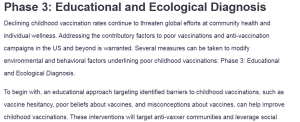Phase 3: Educational and Ecological Diagnosis
Declining childhood vaccination rates continue to threaten global efforts at community health and individual wellness. Addressing the contributory factors to poor vaccinations and anti-vaccination campaigns in the US and beyond is warranted. Several measures can be taken to modify environmental and behavioral factors underlining poor childhood vaccinations: Phase 3: Educational and Ecological Diagnosis.
To begin with, an educational approach targeting identified barriers to childhood vaccinations, such as vaccine hesitancy, poor beliefs about vaccines, and misconceptions about vaccines, can help improve childhood vaccinations. These interventions will target anti-vaxxer communities and leverage social media, contact with caregivers during clinical visits, and community outreach programs in its delivery. Community members, in this respect, will be told of the significance of vaccines on population health. Queries on the safety of vaccines will also be addressed. This may help change the community’s perceptions of vaccines and elevate their adoption of vaccination practices (Machado et al., 2021).
There are several enabling factors for campaigns for childhood vaccinations. Foremost, the abundance of health and healthcare resources supporting childhood vaccinations is likely to increase the campaign’s impact. Healthcare resources such as the CDC, healthcare providers, and vaccination guidelines can be leveraged to improve vaccinations within anti-vaxxer communities. Likewise, federal programs, such as the Vaccine for Children Program, support vaccination even for uninsured children (Oyo-Ita et al., 2023).
The abundance of goodwill, community help groups, and the bold presence of public health agencies such as the CDC continue to reinforce vaccine uptake across communities. Health and vaccine literacy remains high across socioeconomic groups. The American Public Health Association and the CDC also maintain a presence across American communities and continue to provide valuable insights on childhood immunization. This is likely to reinforce campaigns on childhood immunizations.
References
Machado, A. A., Edwards, S. A., Mueller, M., & Saini, V. (2021). Effective interventions to increase routine childhood immunization coverage in low socioeconomic status communities in developed countries: A systematic review and critical appraisal of peer-reviewed literature. Vaccine, 39(22), 2938–2964. https://doi.org/10.1016/j.vaccine.2021.03.088
Oyo-Ita, A., Oduwole, O., Arikpo, D., Effa, E. E., Esu, E. B., Balakrishna, Y., Chibuzor, M. T., Oringanje, C. M., Nwachukwu, C. E., Wiysonge, C. S., & Meremikwu, M. M. (2023). Interventions for improving coverage of childhood immunisation in low- and middle-income countries. Cochrane Database of Systematic Reviews, 2023(12). https://doi.org/10.1002/14651858.cd008145.pub4
ORDER A PLAGIARISM-FREE PAPER HERE
We’ll write everything from scratch
Question 
Phase 3: Educational and Ecological diagnosis – determine what to do in order to change the behavioral and environmental factors in Phase 3, taking into account predisposing factors (knowledge, attitudes, beliefs, values, and confidence); enabling factors (availability of resources, accessibility of services, government laws and policies, issue-related skills), and reinforcing factors (largely the influence of significant others in the social environment). (20 points)

Phase 3: Educational and Ecological Diagnosis
- Example: There are a few different ways to utilize this phase. 1. I can collect my own data using surveys on HPV vaccine rates at Ole Miss. How many people are vaccinated and assess knowledge, attitudes and, beliefs, values? OR, I could look at other data that perhaps has been conducted on other campus or at least in college-age students if I didn’t have time to conduct surveys.
Please link it with previous assignments that were related to childcare and vaccines. I have attached the previous assignments as it needs to build. This is phase 3
